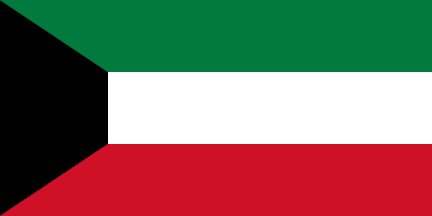
Un artículo en inglés sobre la historia de la bandera de Kuwait.
A symbol of a nation: The Kuwaiti Flag
'The national flag represents the people of a nation, and ours came to mean so much more to us after the invasion and occupation that we survived. Since liberation we hold that flag very dear to our hearts'
By Ahmad Al-Khaled, Staff writer
Flags have traditionally marked ships, castles, and land. But beyond their use as a sign for identification, flags have come to represent the indelible markings of people's love for their homeland. Flags can imbue emotions ranging from fear and pride to joy and tears.
The Kuwaiti flag is no different, for Kuwaitis it is a symbol of their identity.
The national flag represents the people of a nation, and ours came to mean so much more to us after the invasion and occupation that we survived. Since liberation we hold that flag very dear to our hearts," said Jenan Mohammed.
The earliest known flag of Kuwait was called Solaimee. It was a plain red flag, rectangular in shape, with a white zigzag pattern along the far left edge of the flag. It dates back from about 1746 and is known to have been flown by the second Amir of Kuwait, Sheikh Abdullah I. He is said to have adopted the flag as a way of identifying ships in the large Kuwaiti fleet which is thought to have numbered around 800 by the late 1700s.
The white zigzag pattern served to distinguish Kuwait's red flag from the many red flags flown by Gulf ships in the 1700s and 1800s. Red flags date back as early as 700 AD, having been carried by Arab conquerors into Andalusia and North Africa as early as the 711 AD. When the Ottoman Empire was at the height of its power, all its territories throughout the empire were required to fly the Ottoman flag, which was represented by a crescent and star on a red or green background. Although Kuwait was never underOttoman rule, its ships sailed under the Ottoman flag beginning in 1871 through 1914.
The Amir, Sheikh Abdullah II decided to fly the Ottoman flag after Kuwaiti ships had been harassed by Ottoman governors in foreign ports. By flying the Ottoman flag, Kuwaiti ships could avoid harassment as well as evade the taxes and customs duties which were imposed on all non-Ottoman ships. In the early 1900s, after several Kuwaiti ships were seized by the British, Kuwait, under the leadership of Amir Sheikh Mubarek, adopted a national flag which did not carry the Ottoman markings and instead adopted a flag that said 'Kuwait' in white Arabic lettering on a red background.
The British, who had signed an agreement with Kuwait in 1899 making Kuwait a British protectorate, seized the Kuwaiti ships because they were sailing under the Ottoman flag, which was in direct conflict with the protectorate agreement. By 1914, the Ottoman flag was no longer in use. The flag of 1914 took several forms. Flags flown under the state moniker were triangular in shape. Government offices flew a square-shaped flag and ships flew the rectangular version. On some of the flags, Kuwait was written inEnglish and Arabic, while others used the French spelling 'Koweit.
'The old flags were quite interesting, especially the triangular ones. But I like our flag as it is now, as it is our Independence flag," said Yusef Abdullah.
In 1961, Kuwait adopted its current flag under the rule of Amir Sheikh Abdullah Al-Salem. The decision to fly a new flag was made on June 19, 1961 which is the day Kuwait gained full independence from its status as a British Protectorate. The flag was a twist on the Arab Revolt Flag designed by Sharif Hussein who fought in 1916 for the expulsion of the Ottomans from the region.
Hussein succeeded in spreading his flag's colors to destinations throughout the Arab world, where they later became known as the colors representing Pan Arabism. "Our flag is similar to flags in other Arab states. We are proud of the colors which were taken up by the Hashemites and we continue to fly the colors of Arabia today," said Faisal Ali.
On the morning of November 24, 1961 the current flag of Kuwait flew overhead for the very first time. The black trapezoid of Kuwait's modern flag represents the defeat of enemies, red signifies the blood of sacrifice, white represents Arab achievements, and green signifies fertility.
When Kuwaiti soldiers flew the first Kuwaiti flag after the liberation on Qaruh Island, I felt a new attachment to the flag,"said Khaled Issa. "We all now understand the blood of sacrifice, our flag means a lot to me now.

No hay comentarios:
Publicar un comentario